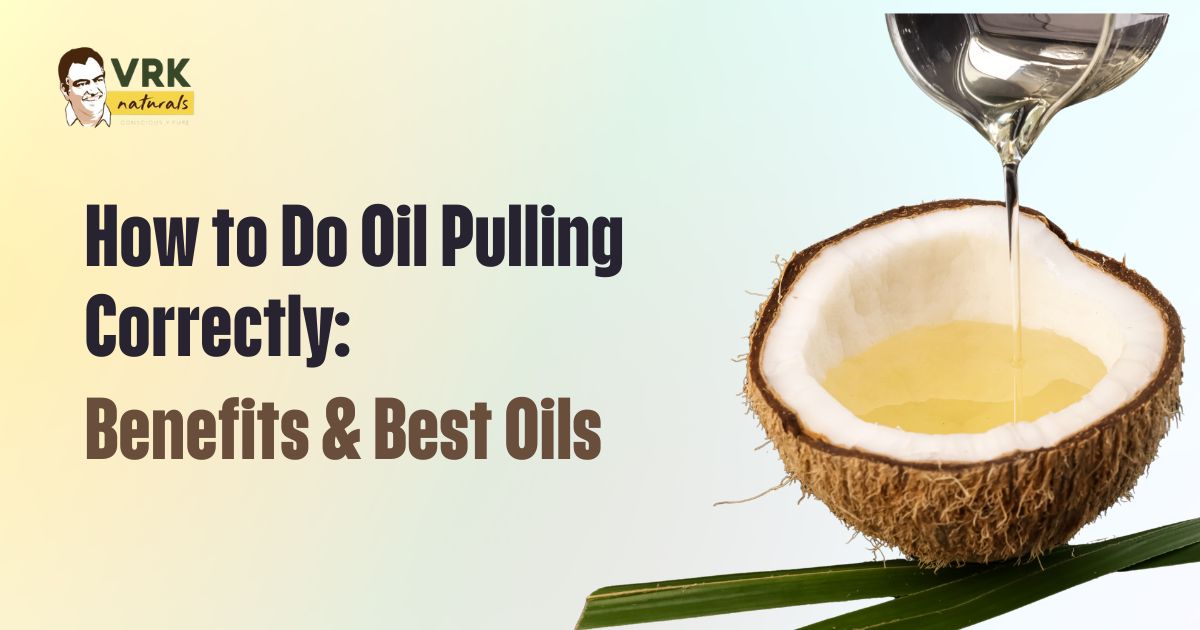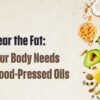Oil Pulling for Beginners: A Step-by-Step Guide to a Healthier Mouth
We brush, we floss, we use mouthwash. Yet, many of us still struggle with common oral health concerns like bad breath, plaque buildup, or sensitive gums. What if one of the most effective solutions wasn’t a modern chemical formula, but an ancient, incredibly simple practice?
Enter oil pulling. This time-tested technique is making a huge comeback, and for good reason. It’s a natural, inexpensive, and powerful way to upgrade your oral hygiene routine.
At VRK Naturals, we believe in the power of pure, traditional wellness. And since the magic of oil pulling lies in the quality of the oil you use, we’ve created this definitive guide to help you get started correctly.
What Exactly Is Oil Pulling?
Oil pulling is an ancient Ayurvedic practice for maintaining oral health, known in Sanskrit as Gandusha or Kavala. The process is simple: you swish a small amount of edible oil in your mouth for a set amount of time, “pulling” it between your teeth and around your gums.
The core idea is that as you swish, the lipids (fats) in the oil bind with the bacteria in your mouth—which live in a lipid membrane—and trap them. When you spit the oil out, you’re removing these harmful microbes along with it.
The Science-Backed Benefits of Oil Pulling
This isn’t just folklore; modern studies have begun to validate the benefits of this ancient practice.
- Reduces Harmful Bacteria: Oil pulling significantly reduces the count of cavity-causing bacteria like Streptococcus mutans.
- Fights Plaque and Gingivitis: Regular practice can be as effective as commercial mouthwash in reducing plaque and fighting gum inflammation (gingivitis).
- Combats Bad Breath (Halitosis): By removing the bacteria responsible for odours, oil pulling is a highly effective remedy for bad breath.
- May Help Whiten Teeth: While not a bleaching agent, oil pulling can help remove surface stains, leading to naturally brighter and whiter-looking teeth over time.
The Big Question: Which VRK Naturals Oil is Best?
The effectiveness of oil pulling is directly linked to the purity of the oil. You must use a high-quality, cold-pressed or wood-pressed oil, as refined oils lack the necessary antimicrobial and anti-inflammatory properties. Here are the two best choices from our range:
1. VRK Naturals Wood-Pressed Coconut Oil
This is the most popular choice for modern oil pullers, primarily due to its high concentration of lauric acid, which has proven antimicrobial and anti-inflammatory effects.
- Why Choose It: It has a milder, more pleasant taste, making it ideal for beginners. Its powerful antimicrobial properties are excellent for fighting germs.
- Get it here: VRK Naturals Wood-Pressed Coconut Oil
2. VRK Naturals Wood-Pressed Sesame Oil
This is the traditional oil used in classic Ayurvedic texts for Gandusha. It has been trusted for centuries to strengthen teeth, gums, and the jaw.
- Why Choose It: It is the original, authentic choice for a traditional Ayurvedic experience. It has potent antioxidant and antibacterial properties.
- Get it here: VRK Naturals Wood-Pressed Sesame Oil
The Verdict: Both are excellent choices! If you are new to oil pulling, you might prefer the taste of coconut oil. If you wish to follow the most traditional Ayurvedic method, sesame oil is your go-to. You can’t go wrong with either pure, wood-pressed option.
How to Do Oil Pulling: A Step-by-Step Guide
Follow these steps for a safe and effective oil pulling session.
Step 1: Timing is Key Perform oil pulling first thing in the morning on an empty stomach, even before drinking water.
Step 2: Measure Your Oil Take one tablespoon of your chosen VRK Naturals oil. If you’re using coconut oil and it’s solid, let it melt in your mouth.
Step 3: Swish Gently Swish the oil around your mouth for 15-20 minutes. This is the ideal duration for the oil to bind with toxins. If you’re a beginner, start with 5 minutes and gradually increase your time. Important: Swish gently. It should be a relaxed action, not a vigorous mouth-washing. Breathe normally through your nose.
Step 4: Spit it Out (Correctly!) When finished, the oil will be thin and milky white. DO NOT SWALLOW IT, as it is now full of bacteria and toxins. Spit it into a dustbin, not your sink or toilet, as the oil can solidify and clog your pipes over time.
Step 5: Rinse and Brush Rinse your mouth thoroughly with warm salt water. Afterwards, brush your teeth as you normally would.
Frequently Asked Questions (FAQ)
- Do I do it before or after brushing? Always before brushing. Oil pulling removes bacteria, and brushing afterwards clears out any remaining residue.
- How often should I do it? For best results, aim for 3-5 times a week, or daily if you prefer.
- I can’t swish for 20 minutes! That’s perfectly fine. Start with 5 minutes and work your way up. Even a short session is beneficial.
- Will I see results immediately? Most people report fresher breath and a cleaner-feeling mouth after the first few sessions. Benefits like reduced plaque and whiter teeth may take a few weeks of consistent practice.
Embrace a Purer Path to Oral Wellness
Oil pulling is a testament to the power of simple, natural solutions. By incorporating this single practice into your morning, you can take a profound step towards better oral health. The key is to honour the tradition with a pure, nutrient-rich, wood-pressed oil that heals rather than harms.
Ready to give it a try? Choose your perfect partner for oral wellness and experience the VRK Naturals difference.
Shop Wood-Pressed Coconut Oil | Shop Wood-Pressed Sesame Oil







